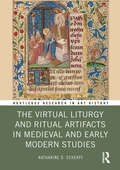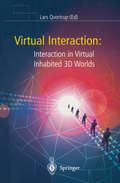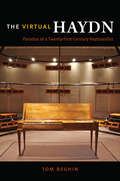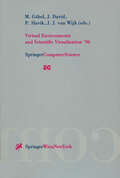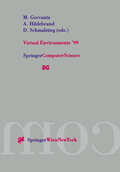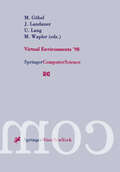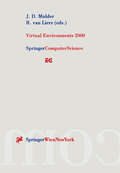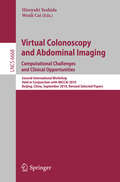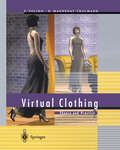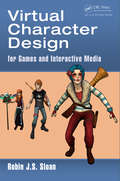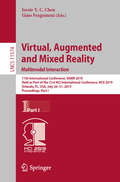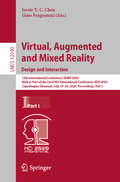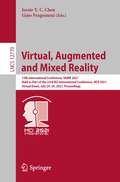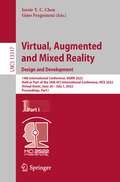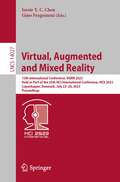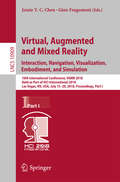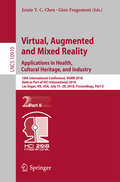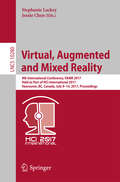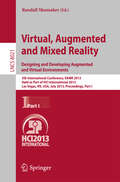- Table View
- List View
The Virtual Liturgy and Ritual Artifacts in Medieval and Early Modern Studies (Routledge Research in Art History)
by Katharine D. ScherffExamining the history of altar decorations, this study of the visual liturgy grapples with many of the previous theoretical frameworks to reveal the evolution and function of these ritual objects. Using an interdisciplinary approach, this book uses traditional ar- historical methodologies and media technology theory to reexamine ritual objects. Previous analysis has not considered the in-between nature of these objects as deliberate and virtual conduits to the divine. The liturgy, the altarpiece, the altar environment, relics, and their reliquaries are media. In a series of case studies, several objects tell a different story about culture and society in medieval Europe. In essence, they reveal that media and media technologies generate and modulate the individual and collective structure of feelings of sacredness among assemblages of humans and nonhumans. The book will be of interest to scholars working in art history, medieval studies, early modern studies, and architectural history.
The Virtual Life of Film
by D. N. RodowickAs almost (or, truly, virtually) every aspect of making and viewing movies is replaced by digital technologies, even the notion of "watching a film" is fast becoming an anachronism. With the likely disappearance of celluloid film stock as a medium, and the emergence of new media competing for an audience, what will happen to cinema--and to cinema studies? In the first of two books exploring this question, D. N. Rodowick considers the fate of film and its role in the aesthetics and culture of moviemaking and viewing in the twenty-first century. Here Rodowick proposes and examines three different critical responses to the disappearance of film in relation to other time-based media, and to the study of contemporary visual culture. Film, he suggests, occupies a special place in the genealogy of the arts of the virtual: while film disappears, cinema persists--at least in the narrative forms imagined by Hollywood since 1915. Rodowick also observes that most so-called "new media" are fashioned upon a cinematic metaphor. His book helps us see how digital technologies are serving, like television and video before them, to perpetuate the cinematic as the mature audiovisual culture of the twentieth century--and, at the same time, how they are preparing the emergence of a new audiovisual culture whose broad outlines we are only just beginning to distinguish.
Virtual Interaction: Interaction in Virtual Inhabited 3D Worlds
by E. Granum B. Holmqvist S. Kolstrup K. Halskov MadsenLars Qvortrup The world of interactive 3D multimedia is a cross-institutional world. Here, researchers from media studies, linguistics, dramaturgy, media technology, 3D modelling, robotics, computer science, sociology etc. etc. meet. In order not to create a new tower of Babel, it is important to develop a set of common concepts and references. This is the aim of the first section of the book. In Chapter 2, Jens F. Jensen identifies the roots of interaction and interactivity in media studies, literature studies and computer science, and presents definitions of interaction as something going on among agents and agents and objects, and of interactivity as a property of media supporting interaction. Similarly, he makes a classification of human users, avatars, autonomous agents and objects, demon strating that no universal differences can be made. We are dealing with a continuum. While Jensen approaches these categories from a semiotic point of view, in Chapter 3 Peer Mylov discusses similar isues from a psychological point of view. Seen from the user's perspective, a basic difference is that between stage and back-stage (or rather: front-stage), i. e. between the real "I" and "we" and the virtual, representational "I" and "we". Focusing on the computer as a stage, in Chapter 4 Kj0lner and Lehmann use the theatre metaphor to conceptualize the stage phenomena and the relationship between stage and front-stage.
The Virtual Haydn: Paradox of a Twenty-First-Century Keyboardist
by Tom BeghinHaydn’s music has been performed continuously for more than two hundred years. But what do we play, and what do we listen to, when it comes to Haydn? Can we still appreciate the rich rhetorical nuances of this music, which from its earliest days was meant to be played by professionals and amateurs alike? With The Virtual Haydn, Tom Beghin—himself a professional keyboard player—delves deeply into eighteenth-century history and musicology to help us hear a properly complex Haydn. Unusually for a scholarly work, the book is presented in the first person, as Beghin takes us on what is clearly a very personal journey into the past. When a discussion of a group of Viennese sonatas, for example, leads him into an analysis of the contemporary interest in physiognomy, Beghin applies what he learns about the role of facial expressions during his own performance of the music. Elsewhere, he analyzes gesture and gender, changes in keyboard technology, and the role of amateurs in eighteenth-century musical culture. The resulting book is itself a fascinating, bravura performance, one that partakes of eighteenth-century idiosyncrasy while drawing on a panoply of twenty-first-century knowledge.
The Virtual Haydn: Paradox of a Twenty-First-Century Keyboardist
by Tom BeghinHaydn’s music has been performed continuously for more than two hundred years. But what do we play, and what do we listen to, when it comes to Haydn? Can we still appreciate the rich rhetorical nuances of this music, which from its earliest days was meant to be played by professionals and amateurs alike? With The Virtual Haydn, Tom Beghin—himself a professional keyboard player—delves deeply into eighteenth-century history and musicology to help us hear a properly complex Haydn. Unusually for a scholarly work, the book is presented in the first person, as Beghin takes us on what is clearly a very personal journey into the past. When a discussion of a group of Viennese sonatas, for example, leads him into an analysis of the contemporary interest in physiognomy, Beghin applies what he learns about the role of facial expressions during his own performance of the music. Elsewhere, he analyzes gesture and gender, changes in keyboard technology, and the role of amateurs in eighteenth-century musical culture. The resulting book is itself a fascinating, bravura performance, one that partakes of eighteenth-century idiosyncrasy while drawing on a panoply of twenty-first-century knowledge.
The Virtual Haydn: Paradox of a Twenty-First-Century Keyboardist
by Tom BeghinHaydn’s music has been performed continuously for more than two hundred years. But what do we play, and what do we listen to, when it comes to Haydn? Can we still appreciate the rich rhetorical nuances of this music, which from its earliest days was meant to be played by professionals and amateurs alike? With The Virtual Haydn, Tom Beghin—himself a professional keyboard player—delves deeply into eighteenth-century history and musicology to help us hear a properly complex Haydn. Unusually for a scholarly work, the book is presented in the first person, as Beghin takes us on what is clearly a very personal journey into the past. When a discussion of a group of Viennese sonatas, for example, leads him into an analysis of the contemporary interest in physiognomy, Beghin applies what he learns about the role of facial expressions during his own performance of the music. Elsewhere, he analyzes gesture and gender, changes in keyboard technology, and the role of amateurs in eighteenth-century musical culture. The resulting book is itself a fascinating, bravura performance, one that partakes of eighteenth-century idiosyncrasy while drawing on a panoply of twenty-first-century knowledge.
The Virtual Haydn: Paradox of a Twenty-First-Century Keyboardist
by Tom BeghinHaydn’s music has been performed continuously for more than two hundred years. But what do we play, and what do we listen to, when it comes to Haydn? Can we still appreciate the rich rhetorical nuances of this music, which from its earliest days was meant to be played by professionals and amateurs alike? With The Virtual Haydn, Tom Beghin—himself a professional keyboard player—delves deeply into eighteenth-century history and musicology to help us hear a properly complex Haydn. Unusually for a scholarly work, the book is presented in the first person, as Beghin takes us on what is clearly a very personal journey into the past. When a discussion of a group of Viennese sonatas, for example, leads him into an analysis of the contemporary interest in physiognomy, Beghin applies what he learns about the role of facial expressions during his own performance of the music. Elsewhere, he analyzes gesture and gender, changes in keyboard technology, and the role of amateurs in eighteenth-century musical culture. The resulting book is itself a fascinating, bravura performance, one that partakes of eighteenth-century idiosyncrasy while drawing on a panoply of twenty-first-century knowledge.
Virtual Environments and Scientific Visualization ’96: Proceedings of the Eurographics Workshops in Monte Carlo, Monaco, February 19–20, 1996, and in Prague, Czech Republic, April 23–25, 1996 (Eurographics)
by Martin Göbel Jaques David Pavel Slavik Jarke Van WijkSelected papers from this year’s Workshops on Virtual Environments and on Visualization in Scientific Computing are included in this volume. The papers on VE discuss Virtual Environment System architecture, communication requirements, synthetic actors, crowd simulations and modeling aspects, application experience in surgery support, geographic information systems, and engineering and virtual housing systems. Contributions from the Visualization workshop are presented in four groups: volume rendering, user interfaces in scientific visualization, architecture of scientific visualization systems and flow visualization.
Virtual Environments ’99: Proceedings of the Eurographics Workshop in Vienna, Austria, May 31–June 1, 1999 (Eurographics)
by Michael Gervautz Axel Hildebrand Dieter SchmalstiegThis book contains the scientific papers presented at the SthEUROGRAPHICS Workshop on Virtual Environments '99, which st st was held in Vienna May 31 and June 1 . It was organized by the Institute of Computer Graphics of the Vienna University of Technology together with the Austrian Academy of Sciences and EUROGRAPHICS. The workshop brought together scientists from all over the world to present and discuss the latest scientific advances in the field of Virtual Environments. 31 papers where submitted for reviewing and 18 where selected to be presented at the workshop. Most of the top research institutions working in the area submitted papers and presented their latest results. These presentations were complemented by invited lectures from Stephen Feiner and Ron Azuma, two key researchers in the area of Augmented Reality. The book gives a good overview of the state of the art in Augmented Reality and Virtual Environment research. The special focus of the Workshop was Augmented Reality, reflecting a noticeable strong trend in the field of Virtual Environments. Augmented Reality tries to enrich real environments with virtual objects rather than replacing the real world with a virtual world. The main challenges include real time rendering, tracking, registration and occlusion of real and virtual objects, shading and lighting interaction, and interaction techniques in augmented environments. These problems are addressed by new research results documented in this book. Besides Augmented Reality, the papers collected here also address levels of detail, distributed environments, systems and applications, and interaction techniques.
Virtual Environments ’98: Proceedings of the Eurographics Workshop in Stuttgart, Germany, June 16–18, 1998 (Eurographics)
by Martin Göbel Jürgen Landauer Ulrich Lang Matthias WaplerTen years after Virtual Environment research started with NASA’s VIEW project, these techniques are now exploited in industry to speed up product development cycles, to ensure higher product quality, and to encourage early training on and for new products. Especially the automotive industry, but also the oil and gas industry are driving the use of these techniques in their works. The papers in this volume reflect all the different tracks of the workshop: reviewed technical papers as research contributions, summaries on panels of VE applications in the automotive, the medical, the telecommunication and the geoscience field, a panel discussing VEs as the future workspace, invited papers from experts reporting from VEs for entertainment industry, for media arts, for supercomputing and productivity enhancement. Short industrial case studies, reporting very briefly from ongoing industrial activities complete this state of the art snapshot.
Virtual Environments ’95: Selected papers of the Eurographics Workshops in Barcelona, Spain, 1993, and Monte Carlo, Monaco, 1995 (Eurographics)
by Martin GöbelVirtual Environments -(VE) the new dimension in man-machine-communication -have been developed and experienced in Europe since 1990. In early 1993 the Eurographics Association decided to establish a working group on Virtual Environments with the aim to communicate advances in this fascinating area on a scientific and technical level. In September 1993 the first workshop on VEs was held in Barcelona, Spain, in conjunction with the annual Eurographics conference. The workshop brought together about 35 researchers from Europe and the US. The second workshop was held together with Imagina '95 in Monte Carlo, Monaco. This time, around 40 researchers from Europe, the US, but also from Asia met for a 2-day exchange of experience. Needless to say -as in all Eurographics workshops -we found the atmosphere very open and refreshing. The workshops were sponsored by ONR (Office of Naval Research), UK; US Army Research Institute, UK; University of Catalonia, Spain; EDF France; CAE France, INA France and IGD Germany and locally organized by Daniele Tost and Jaques David. While in the first workshop in 1993 many concepts in VE were presented, the '95 workshop showed up various applications in different areas and demonstrated quite clearly that Virtual Environments are now used in interactive applications.
Virtual Environments 2000: Proceedings of the Eurographics Workshop in Amsterdam, The Netherlands, June 1–2, 2000 (Eurographics)
by J. D. Mulder R. Van LiereThis book contains the proceedings of the sixth Eurographics Workshop on Vir tual Environments. The event took place from June 1 to June 2, 2000, in Am sterdam. We hope that readers will find these proceedings to be valuable, not only for virtual environment researchers, but also for practitioners developing or using virtual environment applications. We are glad to report that visibility of the workshop continues to expand and that virtual environment researchers and practitioners from allover the world are submitting papers. This year, 40 papers and case studies were submitted of which 20 were accepted. In addition, we are glad to see that the focus of the workshop is also expanding. We accepted 6 research papers on evaluation of virtual environments and there was a broad sampling of other topics. We would like to thank all those involved in organizing the symposium. In particular, thanks go to Mieke Brune who was in charge of the local organization. In addition, we want to thank the international program committee for their excellent, yet laborious, job in reviewing all submitted papers. The quality of the workshop is a reflection of the quality of the submitted papers and the quality of the reviewing process.
Virtual Colonoscopy and Abdominal Imaging: Second International Workshop, Held in Conjunction with MICCAI 2010, Beijing, China, September 20, 2010, Revised Selected Papers (Lecture Notes in Computer Science #6668)
by Hiroyuki Yoshida Wenli CaiThis book constitutes the thoroughly refereed post-conference proceedings of the International Workshop on Computational Challenges and Clinical Opportunities in Virtual Colonoscopy and Abdominal Imaging, held in conjunction with MICCAI 2010, in Beijing, China, on September 20, 2010. The 19 revised full papers presented were carefully reviewed and selected from 26 submissions. The papers are organized in topical sections on CT colonography CAD, abdominal imaging, and virtual colonoscopy.
Virtual Clothing: Theory and Practice
by Pascal Volino Nadia Magnenat-ThalmannIn an accessible style that will appeal to the professional, student and laymen, the authors explain the methods for creating and simulating clothes for virtual humans. Using numerous detailed illustrations, colourful images, and step-by-step analysis they map out the terrain of this exciting and cutting-edge discipline.Starting with the beginnings in the mid 1980s and the basic foundations from the field of mechanics, the reader is gradually introduced to the subject. The text draws on a number of related fields such as computer graphics, algorithmics, computational geometry, simulation, modeling, animation, visualization, and virtual reality. The MIRACloth system, developed by the authors, is used as a case study for the results and techniques discussed. The book comes with a CD-ROM featuring dynamic demonstrations of 3D clothes and fashion shows. This is an indispensable text for anybody who wants an intelligent and readable book on virtual clothing.
Virtual Character Design for Games and Interactive Media
by Robin James SloanWhile the earliest character representations in video games were rudimentary in terms of their presentation and performance, the virtual characters that appear in games today can be extremely complex and lifelike. These are characters that have the potential to make a powerful and emotional connection with gamers. As virtual characters become more
Virtual Character Design for Games and Interactive Media
by Robin James SloanWhile the earliest character representations in video games were rudimentary in terms of their presentation and performance, the virtual characters that appear in games today can be extremely complex and lifelike. These are characters that have the potential to make a powerful and emotional connection with gamers. As virtual characters become more
Virtual, Augmented and Mixed Reality. Multimodal Interaction: 11th International Conference, VAMR 2019, Held as Part of the 21st HCI International Conference, HCII 2019, Orlando, FL, USA, July 26–31, 2019, Proceedings, Part I (Lecture Notes in Computer Science #11574)
by Jessie Y. C. Chen Gino FragomeniThis two-volume set LNCS 11574 and 11575 constitutes the refereed proceedings of the 11th International Conference on Virtual, Augmented and Mixed Reality, VAMR 2019, held in July 2019 as part of HCI International 2019 in Orlando, FL, USA. HCII 2019 received a total of 5029 submissions, of which 1275 papers and 209 posters were accepted for publication after a careful reviewing process. The 80 papers presented in this volume were organized in topical sections named: multimodal interaction in VR, rendering, layout, visualization and navigation, avatars, embodiment and empathy in VAMR, cognitive and health issues in VAMR, VAMR and robots, VAMR in learning, training and entertainment, VAMR in aviation, industry and the military.
Virtual, Augmented and Mixed Reality. Design and Interaction: 12th International Conference, VAMR 2020, Held as Part of the 22nd HCI International Conference, HCII 2020, Copenhagen, Denmark, July 19–24, 2020, Proceedings, Part I (Lecture Notes in Computer Science #12190)
by Gino Fragomeni Jessie Y. C. ChenThe 2 volume-set of LNCS 12190 and 12191 constitutes the refereed proceedings of the 12th International Conference on Virtual, Augmented and Mixed Reality, VAMR 2020, which was due to be held in July 2020 as part of HCI International 2020 in Copenhagen, Denmark. The conference was held virtually due to the COVID-19 pandemic.A total of 1439 papers and 238 posters have been accepted for publication in the HCII 2020 proceedings from a total of 6326 submissions.The 71 papers included in these HCI 2020 proceedings were organized in topical sections as follows:Part I: design and user experience in VAMR; gestures and haptic interaction in VAMR; cognitive, psychological and health aspects in VAMR; robots in VAMR.Part II: VAMR for training, guidance and assistance in industry and business; learning, narrative, storytelling and cultural applications of VAMR; VAMR for health, well-being and medicine.
Virtual, Augmented and Mixed Reality: 13th International Conference, VAMR 2021, Held as Part of the 23rd HCI International Conference, HCII 2021, Virtual Event, July 24–29, 2021, Proceedings (Lecture Notes in Computer Science #12770)
by Jessie Y. C. Chen Gino FragomeniThis book constitutes the refereed proceedings of the 13th International Conference on Virtual, Augmented and Mixed Reality, VAMR 2021, held virtually as part of the 23rd HCI International Conference, HCII 2021, in July 2021. The total of 1276 papers and 241 posters included in the 39 HCII 2021 proceedings volumes was carefully reviewed and selected from 5222 submissions. The 47 papers included in this volume were organized in topical sections as follows: designing and evaluating VAMR environments; multimodal and natural interaction in VAMR; head-mounted displays and VR glasses; VAMR applications in design, the industry and the military; and VAMR in learning and culture.
Virtual, Augmented and Mixed Reality: 14th International Conference, VAMR 2022, Held as Part of the 24th HCI International Conference, HCII 2022, Virtual Event, June 26 – July 1, 2022, Proceedings, Part I (Lecture Notes in Computer Science #13317)
by Jessie Y. C. Chen Gino FragomeniThis two-volume set LNCS 13317 and 13318 constitutes the thoroughly refereed proceedings of the 14th International Conference on Virtual, Augmented and Mixed Reality, VAMR 2022, held virtually as part of the 24rd HCI International Conference, HCII 2022, in June/July 2022.The total of 1276 papers and 241 posters included in the 39 HCII 2021 proceedings volumes was carefully reviewed and selected from 5222 submissions. The 56 papers included in this 2-volume set were organized in topical sections as follows: Developing VAMR Environments; Evaluating VAMR environments; Gesture-based, haptic and multimodal interaction in VAMR; Social, emotional, psychological and persuasive aspects in VAMR; VAMR in learning, education and culture; VAMR in aviation; Industrial applications of VAMR. The first volume focuses on topics related to developing and evaluating VAMR environments, gesture-based, haptic and multimodal interaction in VAMR, as well as social, emotional, psychological and persuasive aspects in VAMR, while the second focusses on topics related to VAMR in learning, education and culture, VAMR in aviation, and industrial applications of VAMR.
Virtual, Augmented and Mixed Reality: 15th International Conference, VAMR 2023, Held as Part of the 25th HCI International Conference, HCII 2023, Copenhagen, Denmark, July 23–28, 2023, Proceedings (Lecture Notes in Computer Science #14027)
by Jessie Y. C. Chen Gino FragomeniThis book constitutes the refereed proceedings of the 15th International Conference on Virtual, Augmented and Mixed Reality, VAMR 2023, held as part of the 25th International Conference, HCI International 2023, in Copenhagen, Denmark, in July 2023. The total of 1578 papers and 396 posters included in the HCII 2022 proceedings was carefully reviewed and selected from 7472 submissions. The VAMR 2023 proceedings were organized in the following topical sections: Designing VAMR Applications and Environments; Visualization, Image Rendering and 3D in VAMR; Multimodal Interaction in VAMR; Robots and Avatars in Virtual and Augmented Reality; VAMR in Medicine and Health; VAMR in Aviation; and User Experience in VAMR.
Virtual, Augmented and Mixed Reality: 10th International Conference, VAMR 2018, Held as Part of HCI International 2018, Las Vegas, NV, USA, July 15-20, 2018, Proceedings, Part I (Lecture Notes in Computer Science #10909)
by Jessie Y.C. Chen Gino FragomeniThis two-volume set LNCS 10909 and 10910 constitutes the refereed proceedings of the 10th International Conference on Virtual, Augmented and Mixed Reality, VAMR 2018, held as part of HCI International 2018 in Las Vegas, NV, USA. HCII 2018 received a total of 4346 submissions, of which 1171 papers and 160 posters were accepted for publication after a careful reviewing process. The 65 papers presented in this volume were organized in topical sections named: interaction, navigation, and visualization in VAMR; embodiment, communication, and collaboration in VAMR; education, training, and simulation; VAMR in psychotherapy, exercising, and health; virtual reality for cultural heritage, entertainment, and games; industrial and military applications.
Virtual, Augmented and Mixed Reality: 10th International Conference, VAMR 2018, Held as Part of HCI International 2018, Las Vegas, NV, USA, July 15-20, 2018, Proceedings, Part II (Lecture Notes in Computer Science #10910)
by Jessie Y.C. Chen Gino FragomeniThis two-volume set LNCS 10909 and 10910 constitutes the refereed proceedings of the 10th International Conference on Virtual, Augmented and Mixed Reality, VAMR 2018, held as part of HCI International 2018 in Las Vegas, NV, USA. HCII 2018 received a total of 4346 submissions, of which 1171 papers and 160 posters were accepted for publication after a careful reviewing process. The 65 papers presented in this volume were organized in topical sections named: interaction, navigation, and visualization in VAMR; embodiment, communication, and collaboration in VAMR; education, training, and simulation; VAMR in psychotherapy, exercising, and health; virtual reality for cultural heritage, entertainment, and games; industrial and military applications.
Virtual, Augmented and Mixed Reality: 9th International Conference, VAMR 2017, Held as Part of HCI International 2017, Vancouver, BC, Canada, July 9-14, 2017, Proceedings (Lecture Notes in Computer Science #10280)
by Stephanie Lackey Jessie ChenThis book constitutes the refereed proceedings of the 9th International Conference on Virtual, Augmented and Mixed Reality, VAMR 2017, held as part of HCI International 2017 in Vancouver, BC, Canada. HCII 2017 received a total of 4340 submissions, of which 1228 papers were accepted for publication after a careful reviewing process. The 45 papers presented in this volume were organized in topical sections named: developing virtual and augmented environments; interaction techniques in VAMR; VAMR in education and training; virtual worlds and games; user experience in VAMR; and health issues in VR.
Virtual, Augmented and Mixed Reality: 5th International Conference, VAMR 2013, Held as Part of HCI International 2013, Las Vegas, NV, USA, July 21-26, 2013, Proceedings, Part I (Lecture Notes in Computer Science #8021)
by Randall ShumakerHere is the first of a two-volume set (LNCS 8021 and 8022) that constitutes the refereed proceedings of the 5th International Conference on Virtual, Augmented and Mixed Reality, VAMR 2013, held as part of the 15th International Conference on Human-Computer Interaction, HCII 2013, held in Las Vegas, USA in July 2013, jointly with 12 other thematically similar conferences. The total of 1666 papers and 303 posters presented at the HCII 2013 conferences was carefully reviewed and selected from 5210 submissions. These papers address the latest research and development efforts and highlight the human aspects of design and use of computing systems. The papers accepted for presentation thoroughly cover the entire field of human-computer interaction, addressing major advances in knowledge and effective use of computers in a variety of application areas. The total of 88 contributions included in the VAMR proceedings were carefully reviewed and selected for inclusion in this two-volume set. The papers included in this volume are organized in the following topical sections: developing augmented and virtual environments, interaction in augmented and virtual environments, human-robot interaction in virtual environments, and presence and tele-presence. ; healthcare and medical applications; virtual and augmented environments for learning and education; business, industrial and military applications; culture and entertainment applications.
